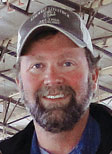 Scott and Michelle Ramsey have raised Cargill turkeys for 20 years on 250 acres in Summers, Ark. The hen raising operation consists of one brooding house with 17,000 poults and two grow-out houses with another 17,000 hens staying for a total of 12 to 13 weeks. Scott clearly remembers March 1989, when Arkansas was hit with a serious winter storm and he helped to save brood birds from being destroyed on property he was to purchase six years later. Scott said, “I worked all night for chocolate chip cookies, but they were worth it.”
Scott and Michelle Ramsey have raised Cargill turkeys for 20 years on 250 acres in Summers, Ark. The hen raising operation consists of one brooding house with 17,000 poults and two grow-out houses with another 17,000 hens staying for a total of 12 to 13 weeks. Scott clearly remembers March 1989, when Arkansas was hit with a serious winter storm and he helped to save brood birds from being destroyed on property he was to purchase six years later. Scott said, “I worked all night for chocolate chip cookies, but they were worth it.”
One of the biggest differences between raising turkeys and raising chickens is that at least one of the houses is occupied at all times because the cleanout and maintenance period for the brooding and growing-out houses are staggered. The Ramseys began by raising toms but switched to hens about 4 years ago when Cargill decided to move the toms further north to Missouri and bring the hens to Arkansas to take better advantage of natural climate averages. In general, the hens are sold as whole birds while the much larger toms are further processed for consumer products such as ground turkey, turkey bologna or turkey bacon.
Other differences between the chicken and turkey industries are that turkey genetics have changed little since the Ramseys started and that improvements in raising methods have not required extensive structural or refitting changes in the houses. Consequently the Ramsey brooding house is 50 years old while the rebuilt grow-out houses are approaching 26. Scott said, “Continuous and meticulous maintenance keep the houses viable. You are constantly fixing or replacing something from curtains to fans to waterers.” Michelle said, “I can handle the place by myself if Scott goes out of town, but he never leaves me when the maintenance work needs to be done, when the brooders arrive or when the birds are transferred to the grow-out houses. When the transfer occurs, a pathway is cordoned off using portable orange construction fence. Additionally, a plastic pipe with a red flag on the end is used to encourage the birds to make the necessary 250 foot transition to the grow-out houses.
Cargill reproduces the turkeys using AI because the toms are too big for the hens and then hatches them before delivery to the producer. New arrivals are hand delivered a crumble starter feed for 10 days using a wheelbarrow. Then the young turkeys are fed a series of four pellet types nutritionally designed for different stages of the birds’ growth.
According to Scott, the biggest change in the turkey industry is transparency. He said, “Farmers as a whole take better care of their animals than themselves. The difference now is consumers want proof of what we do.” Michelle agreed, “We haven’t really changed what we do, just some of the steps. For example we now go through our field man and a vet to get a prescription when the birds become sick. We used to contact our field man and he would make the decision to initiate treatment without the vet prescription. The new system, however, is efficient, and delays treatment by perhaps only one day with the added benefit of consumers being assured of product quality.”
While the Ramseys milked cows for 14 years, they have always raised commercial cattle. As their children Cassy, Devan, and Audie grew older and family activities became more time consuming, Scott and Michelle decided to discontinue milking and expand their commercial herd. They currently have 60 Charolais cross mommas bred by two Red Angus bulls. Scott said, “Our yellow-red cattle sell well while maintaining the Angus body structure so favored by the market.” Breeding season is controlled by pulling the bulls from September to December and from March to June. Calves are sold at 500 to 600 pounds at the Stilwell Livestock Auction after being vaccinated, dewormed and castrated. Scott castrates rather than bands because he believes it is more humane since the process is quick and the calves heal up in a week.
Not surprisingly, pastures and hay fields are fertilized with turkey litter according to government regulation. The Ramsey land is predominantly Bermuda and Fescue with some white clover. Scott hays 130 acres hoping for three cuttings in a good year, and pastures are sometimes seeded with wheat for nutritious winter grazing. Finally, Scott supplements with mineral and protein licks.
Scott said, “Farming has been good to us and helped raise our three children. The truth is farming is more than a living, it’s a lifestyle and you get out of it what you put into it. In 10 years, however, I would like to retire from the poultry industry, increase my herd by another 60 mommas and travel with Michelle.”







